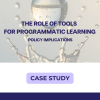Donor perceptions and processes: Risks to success of adaptive programming?
During a workshop on adaptive programming (AP), participants explored the experience gained on three projects currently being delivered in an adaptive way – the UK government (DFID) funded Legal Assistance for Economic Reform (LASER) program implemented by KPMG and The Law & Development Partnership, ODI’s evaluation of support to community dispute resolution in Asia delivered by The Asia Foundation, and the International Development Law Organization’s research work on the impact of land tenure registration on land disputes and women’s rights in Burundi.
It was interesting to me that a number of lessons from the application of an adaptive approach were similar - even where the programs varied in the topic covered, the overall technical approach and the stage in the program lifecycle the initiative was at – and I wanted to share three of the key points I took away from the event.
Lesson 1: Adaptive programming is about more than MEL
Participants agreed that monitoring, learning & evaluation (MEL) is central to an adaptive approach, and strategies to, on an ongoing basis, gather high quality data should be put in place. However, of equal importance is the allocation of time and resources to engage with and reflect on this data, in real time. The ability to observe and consciously reflect on what is happening while it is happening – and to in a transparent and well documented manner change what you do and how you do it as a result of this information – is paramount to an adaptive approach.
To do this, we need to view AP as about more than undertaking increased / innovative / better MEL. As one participant pointed out, his program was ‘already drowning in data’ and had access to far more information than it could effectively deal with. A key requirement of an adaptive program is the ability to revise technical approaches or back-office operations in response to the findings of MEL activities, with the aim of increasing the impact of the project. To do this we need to develop and operationalize program management and oversight processes which allow changes to be made at both the strategic level (theories of change, results frameworks) and operational level (systems, tools, resources, budget) of a program – and to do this quickly, efficiently and on an ongoing basis.
Lesson 2: Adaptive programming offers an opportunity to align practice and design
Adaptive programming is also about being open and transparent about the changes we make, and why we make them. As a representative from a large international NGO pointed out, ‘the current reality is that donor accountability and reporting requirements often necessitate a type of reverse engineering by project managers, to translate that which actually happened on a project, into that which was expected and agreed upfront’. Although we might have worked in accordance with the broad principles of AP on projects in the past, (i.e. reacted to changes in the political context and in client needs, and changed that which didn’t work), we have often done this ‘under the radar’ as a result of the constraints of traditional program design, management and reporting approaches.
AP is therefore also about finding ways in which adaptation, informed by learning, can be undertaken in a transparent manner, acknowledged by suppliers and project partners, and sanctioned by donors. It is equally about finding ways in which these adaptations can be made speedily, for example without continuous requests for approval or contract amendments, and by those closest to operational developments (frontline staff or local implementers, not project managers working remotely) - without this approach being detrimental to a donor’s ability to hold its suppliers accountable (or more complexly, to pay suppliers based on performance).
Lesson 3: Adaptive programming requires a change in mindset
Over the past two years, much support has been generated for working in a more politically smart, problem driven and iterative manner. The third key take away from the event for me was however that AP is not only about ‘doing technical support differently’; it also requires us to query and revise some of the views we hold on what I will call the 1) advisor-beneficiary and 2) donor-supplier relationships.
In the programs discussed, it was apparent that AP was viewed as more than how and when we deliver technical support, what we provide advice on, or which activities we scale up and which we close down. Instead, local counterparts / beneficiaries were treated as active participants in the project, rather than being viewed as ‘stakeholders’ who needed to ‘buy-in’ to predetermined solutions designed by ‘experts’. In addition to acknowledging the political context and local needs as a driving force behind project decisions, an adaptive approach allows us to test the solutions proposed and developed by local parties. As one LASER government partner expressed it, adaptive programming requires donors to ‘trust that their collaborators have a modicum of intelligence and a modicum of an idea of what they need to do and therefore all you [the advisor] need to do is facilitate and be true partners’.
As to the donor-supplier relationship, the success of an adaptive approach depends less on the ability of these two parties to undertake extensive preparatory analyses, pin program details down up front, and deliver/oversee provision of support in accordance with a pre-approved, linear plan. Instead, a relationship of trust, a joint vision of what can be achieved, a shared culture of innovation, knowledge sharing and a desire to learn from failure, as well as the availability of staff with strong soft skills (such as facilitation, networking, and relationship building skills) are necessary. For adaptive programs to succeed, the current principal-agent relationship between donors and their suppliers will need to be revisited to enable greater collaboration and flexibility.
Will AP become a mainstream approach?
This brings me to the overarching conclusion I drew from the workshop: the acknowledgement that donor views, approaches and systems ultimately enable or hinder adaptive working – and that this poses one of the greatest risks to the industry-wide uptake of adaptive programming. I think there is a real risk that AP will not become the game changer academics and practitioners believe it could be, able to significantly improve our ability to increase the impact of development programs, unless:
- Donors and suppliers are prepared to invest time and effort in jointly developing result frameworks, and program management and oversight systems and tools which allow technical flexibility, while addressing the taxpayers’ need for appropriate management of risk and accountability;
- Donor and supplier procurement, contracting and program management staff (and not only technical experts) are included in the discussion around AP - and are willing to develop and test different approaches to the design, procurement, contracting and oversight of programs which encourage learning by doing, trial and error, and risk-taking. These approaches should also enable project activities to be scaled up and closed down quickly and easily throughout the life of the program;
- Donors are willing to view increased MEL and program management costs as worthwhile investments made to improve the ability of programs to achieve impact, rather than viewing these costs as overheads which reduce the amount available for project activities and which impact negatively on value for money;
- Donors, suppliers and researchers are willing to experiment with cost effective ways to generate data for learning; not only does this include developing new tools for data collection and using technology better, but also acknowledging that data of use to manage adaptively (e.g. qualitative data on the barriers users face in accessing services) might differ from data required for program evaluation (e.g. quantitative data on the number of service users accessing services), and adjusting expectations and efforts accordingly;
- Suppliers and practitioners prove that the increased investment in MEL and program management required to design and deliver adaptive programs ultimately translates into (greater) impact, and that there is a causal relationship between this impact and AP;
- Donors overcome their skepticism towards adaptive programming, shaking off the view that AP opens the door to suppliers to play loose and fast with results to their own advantage;
- Donors – and more importantly – politicians and taxpayers, 1) start to take a longer-term view of impact and value for money, demonstrating a willingness to measure the success of programs over longer time periods, and 2) become more comfortable with a culture of experimentation, acknowledging not everything tried in development will work the first time.
Adaptive programming in and of itself is not new – practitioners have long altered technical solutions and delivery mechanisms on the ground as programs unfolded. However, it is necessary that donors and suppliers acknowledge that we are a long way from the systemic uptake of structures and processes which enables, encourages and rewards greater impact as a result of learning and adaptation.







Login or register for free to get all access to our network publications. Members can also connect and discuss with other members. Participate in our network.